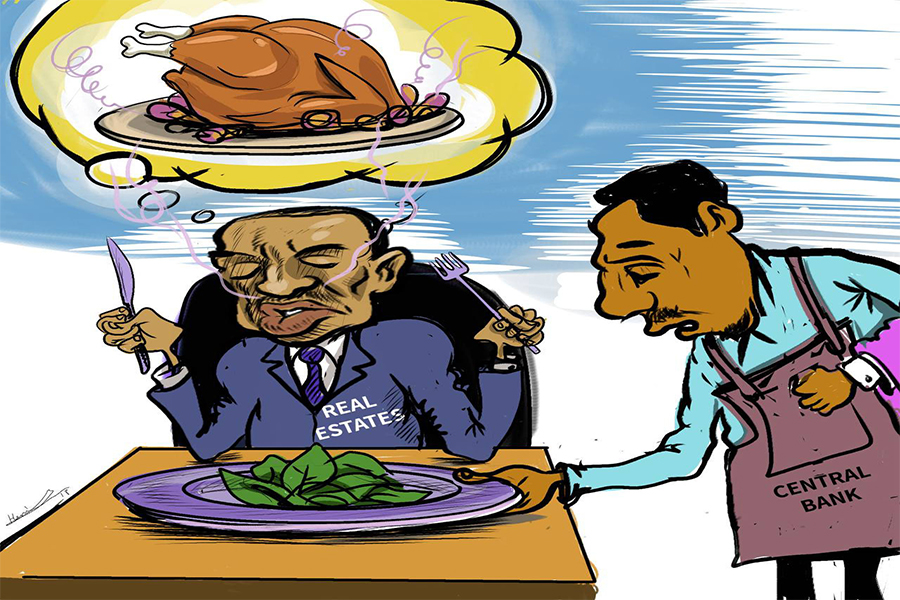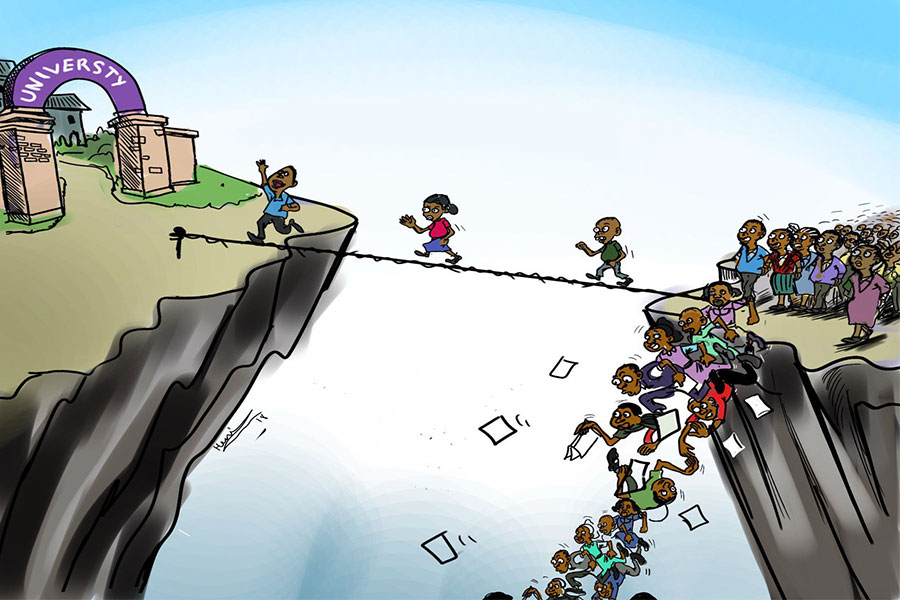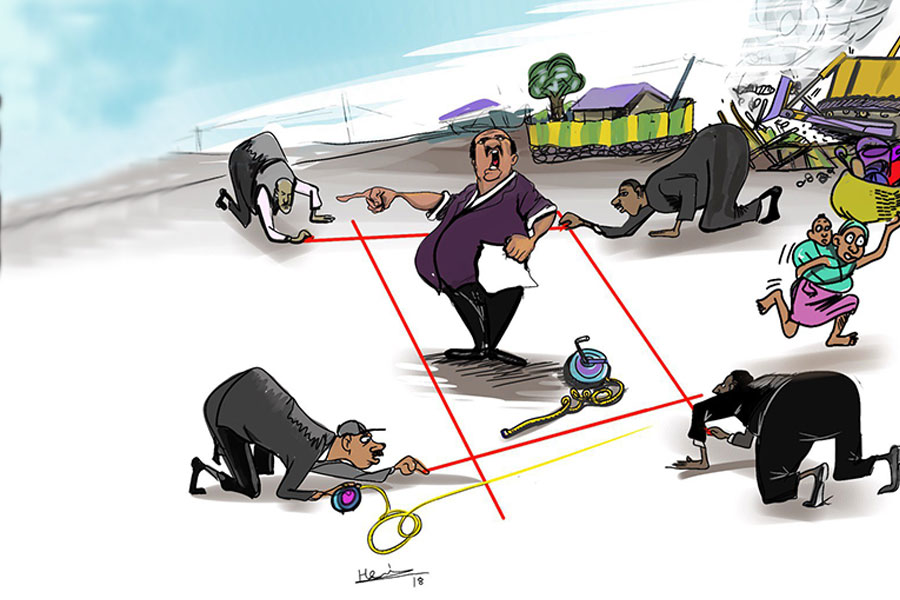
Photo Gallery | 173812 Views | May 06,2019
Sep 20 , 2025. By Daniel Kassahun (PhD) ( Daniel Kassahun (PhD) is an associate professor of Geographic Information Systems (GIS) based in Austin, Texas. He publishes in peer-reviewed journals and shares occasional perspectives on newspapers dealing with the spatial dimensions of environmental and socioeconomic challenges facing Ethiopia. )
Few national efforts have captured the imagination quite like the GERD. From schoolchildren donating spare coins to citizens in distant villages tracking progress through battery radios, GERD is more than a concrete structure but a story of collective aspiration. It stands on the Blue Nile, its 70-billion-cubic-meter reservoir already nicknamed “Nigat Lake”.
At dusk on New Year’s Eve of the Julian calendar, September 9, 2025, Ethiopia flicked the switch on the Grand Ethiopian Renaissance Dam (GERD), ending 14 years of cement-pouring, diplomatic sparring and public fund-raising. The five billion dollar dam is ready to pump more than 5,000MW of clean power into Africa’s grid, making it the continent’s largest hydro project. For Ethiopians, it is erected as a concrete symbol of self-reliance.
The GERD’s story, however, is bigger than numbers and turbines. It is not the brainchild of one leader, whether the late Prime Minister Meles Zenawi, who first drew the blueprints, or his successor Abiy Ahmed (PhD), who pushed it to the finish line. It is a collective endeavour that Ethiopia can shift its economic centre of gravity from the crowded highlands to the once-ignored lowlands, and in doing so, change its destiny.
For centuries, the highlands were both shield and stronghold. Their cool plateaus repelled malaria and, in 1896 at Adwa, helped Ethiopian forces turn back Italy’s modern army. Geography was a defence. Yet, that mountain focus came at a steep price. Low-lying corridors to the Red Sea were left exposed; outsiders, from early Arab traders to 19th-century Italians who carved out Eritrea, walked in almost unopposed. Ethiopia eventually lost its own coast and became landlocked, a strategic wound that still aches.
The land itself shows the toll. Generations of farmers ploughed steeper and thinner soils; erosion on cultivated plots now reaches 42tns a hectare each year. The highlands, once the country’s breadbasket, bear deep scars, while the lowlands stayed peripheral, deemed too hot, too malarial or too far. It was, to borrow one scholar’s phrase, like guarding the staircase while leaving the front door ajar.
Global patterns show the missed opportunity. Modern growth usually springs from open and well-connected lowlands. China’s boom started not in its northern interior but in coastal Shenzhen and Shanghai. Vietnam found traction in the Mekong Delta and Ho Chi Minh City; Thailand’s wealth pools in the flat Chao Phraya basin. By contrast, mountain-bound Nepal, Bhutan, Afghanistan and Lesotho still wrestle with poor soils, complex logistics and thin capital. Geography, it appears, can be a cradle or a cage.
The GERD is Ethiopia’s bid to pick the lock. Rising in the western lowlands near Sudan, it joins a string of projects that signal a new map. Far to the east, the Ogaden gas fields and a planned 2.5 billion dollar fertiliser plant in Gode could turn raw resources into industry. Economists call these big bets “growth poles”, investments that pull money, talent and roads in their orbit.
Already, the GERD’s 70-billion-cubic-meter reservoir, dubbed "Nigat Lake," spawns talk of eco-tourism, commercial fisheries and weekend resorts to complement Ethiopia’s highland monasteries and rock-hewn churches. More pressing should be the power itself. Millions of households that now cook with wood or crop stalks could switch to electricity, easing the deforestation and soil loss that darken satellite photos every year.
None of this is wired for automatic success. Ethno-national tensions, rigid regional boundaries and pockets of open conflict still cramp trade and sow mistrust. For the GERD’s surge of kilowatts to translate into jobs and factories, the federal government will have to act less like a referee of rival regions and more like what one official calls a “national facilitator,” clearing red tape, opening internal markets and nudging provinces to share power lines instead of fighting over them.
Rewriting parts of the 1995 constitution, a patchwork of ethno-linguistic regions, may move from academic debate to economic necessity. Political currents are tricky. Some highland elites fear losing influence as the lowlands rise; newly assertive lowland leaders want a louder voice in Addis Abeba.
Outside Ethiopia, Egypt still sees any upstream dam as a threat to its own Nile lifeline, while Sudan weighs potential flood control gains against water-supply risks. Diplomacy will matter as much as concrete.
History offers both warnings and road maps. Saudi Arabia transformed oil into skyscrapers; Norway turned North Sea crude into the world’s largest sovereign wealth fund; Botswana used diamonds to leap from dirt roads to middle-income status. Nigeria and Equatorial Guinea, awash in hydrocarbons yet mired in inequality, show how fast windfalls can sour. Which model Ethiopia follows depends on how quickly it can channel wattage into factories, schools and export corridors.
Napoleon liked to say, “Geography is destiny.” Ethiopia is trying to edit that script. The highlands that once defined its survival may no longer define its future. Down in the lowlands, where rivers slow and plains widen, turbines now spin with a low hum that carries a louder message. The margins have become the centre. If the country manages its new current wisely, the GERD won’t only light homes. It could power a wholesale shift, from scarcity to surplus, from mountain refuge to lowland opportunity, rewriting a national story that has too often been told in terms of what Ethiopia lacks rather than what it can build.
PUBLISHED ON
Sep 20,2025 [ VOL
26 , NO
1325]

Photo Gallery | 173812 Views | May 06,2019

Photo Gallery | 164038 Views | Apr 26,2019

Photo Gallery | 154098 Views | Oct 06,2021

My Opinion | 136582 Views | Aug 14,2021

Oct 11 , 2025
Ladislas Farago, a roving Associated Press (AP) correspondent, arrived in Ethiopia in...

Oct 4 , 2025
Eyob Tekalegn (PhD) had been in the Governor's chair for only weeks when, on Septembe...

Sep 27 , 2025
Four years into an experiment with “shock therapy” in education, the national moo...

Sep 20 , 2025
Getachew Reda's return to the national stage was always going to stir attention. Once...